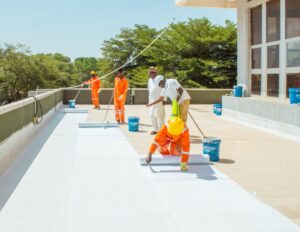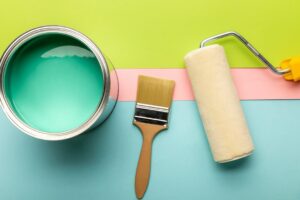Introduction
Outdoor painting projects require more than just choosing a color you love; they demand durability, weather resistance, and careful planning to ensure long-lasting results. Weather exposure can cause paint to fade, crack, or peel if the wrong type of paint or coating is used.
This guide will walk you through the importance of weather-resistant coatings, tips for selecting the right ones, and practical advice for achieving a professional-quality finish that stands up to the elements.
1. Understanding Weather-Resistant Coatings
Weather-resistant coatings are specially formulated paints and finishes designed to endure various environmental factors, including:
- UV Radiation: Prolonged exposure to the sun can cause paint to fade, chalk, or degrade over time.
- Moisture and Rain: Rain, humidity, and dew can lead to water damage, peeling, or bubbling.
- Temperature Fluctuations: Expanding and contracting surfaces from hot and cold weather can stress paint, leading to cracks.
- Wind and Abrasion: Dust, debris, and wind can wear down paint surfaces, especially in exposed areas.
These coatings are created to offer superior adhesion, flexibility, and protection, ensuring your outdoor surfaces look great for years while resisting the harshest conditions.
2. Factors to Consider When Choosing Outdoor Paint
1. Surface Type
The type of surface you’re painting—wood, metal, concrete, brick, or vinyl—affects the kind of paint or coating you need.
- Wood: Look for paints that offer flexibility to accommodate wood’s natural expansion and contraction.
- Metal: Use rust-inhibiting primers and paints designed for metal surfaces to prevent corrosion.
- Concrete and Masonry: Choose breathable, alkali-resistant coatings that prevent moisture trapping and efflorescence.
- Vinyl or Plastic: Opt for lightweight, fade-resistant coatings that won’t crack under UV exposure.
2. Climate and Weather Conditions
Your local climate plays a significant role in determining the ideal paint or coating.
- Hot and Sunny Climates: Use UV-resistant paints with fade-resistant pigments.
- Rainy or Humid Areas: Choose water-repellent or mold-resistant coatings to protect against moisture damage.
- Cold or Freezing Regions: Look for flexible, freeze-thaw resistant paints.
3. Paint Finish
The finish you choose impacts durability and appearance:
- Glossy Finishes: Best for surfaces that need extra protection, such as doors and trim. They repel moisture and are easy to clean.
- Satin Finishes: Offer a balance of durability and aesthetics, suitable for siding and larger surfaces.
- Matte Finishes: Better for hiding surface imperfections but may require more frequent maintenance.
3. Types of Weather-Resistant Coatings
1. Acrylic Latex Paint
- Benefits: Excellent for wood, masonry, and siding. It’s flexible, UV-resistant, and resistant to cracking.
- Best For: General exterior painting projects.
2. Oil-Based Paint
- Benefits: Provides a durable finish and superior adhesion but can yellow over time.
- Best For: Metal surfaces or areas requiring high durability.
3. Elastomeric Coatings
- Benefits: Highly flexible and ideal for surfaces that expand and contract, such as stucco or masonry.
- Best For: Homes in regions with significant temperature changes.
4. Epoxy Coatings
- Benefits: Extremely durable, chemical-resistant, and waterproof.
- Best For: Garage floors, patios, or industrial surfaces exposed to heavy wear.
5. Polyurethane Coatings
- Benefits: Offers UV protection and a tough, long-lasting finish.
- Best For: Wood decks, outdoor furniture, and metal railings.
4. Preparation is Key for Outdoor Painting Projects
1. Clean the Surface Thoroughly
Dirt, mold, and peeling paint must be removed for proper adhesion.
- Use a power washer for large surfaces like siding or concrete.
- For mold or mildew, use a solution of water and bleach.
2. Repair Damage
Fix cracks, holes, or other imperfections to ensure a smooth surface.
- Use wood filler for damaged wood.
- Apply masonry filler for cracks in concrete or brick.
3. Sand the Surface
Sanding helps remove loose paint and creates a smooth surface for new paint to adhere.
4. Use the Right Primer
Primers ensure paint adheres better and provide an even base.
- Stain-blocking primers: For surfaces with water or rust stains.
- Rust-inhibiting primers: Essential for metal surfaces.
- Masonry primers: Prevent efflorescence and moisture issues on concrete or brick.
5. Application Tips for a Durable Finish
1. Choose the Right Tools
- Brushes and Rollers: High-quality brushes or rollers ensure even application.
- Sprayers: Ideal for large or textured surfaces.
2. Paint in Optimal Weather Conditions
- Avoid painting in extreme heat, cold, or high humidity.
- Ideal temperature range: 50–85°F (10–30°C).
3. Apply Multiple Thin Coats
- Thin coats dry faster and adhere better than thick layers.
- Follow the manufacturer’s drying time recommendations.
4. Seal with a Topcoat
For added durability, apply a weather-resistant sealant or topcoat after the final paint layer.
6. Common Mistakes to Avoid
- Skipping Primer: Primer is crucial for proper paint adhesion and durability.
- Ignoring Surface Imperfections: Unrepaired cracks or holes will compromise the finish.
- Painting in Poor Weather: Painting in high humidity or extreme temperatures can lead to blistering or poor adhesion.
- Using the Wrong Paint: Ensure the paint is specifically designed for exterior use and the surface type.
7. Maintaining Your Painted Surfaces
Even the best weather-resistant coatings require maintenance to keep them looking fresh:
- Inspect Regularly: Check for signs of wear, such as peeling, cracking, or fading.
- Clean Annually: Use a mild detergent and soft brush or cloth to remove dirt and grime.
- Touch Up As Needed: Promptly repair small chips or cracks to prevent further damage.
Finally,
Outdoor painting projects can transform your home’s curb appeal and protect surfaces from harsh weather conditions. By selecting the right weather-resistant coatings and taking the time to prepare and apply them properly, you’ll ensure a long-lasting, flawless finish.
From choosing the right product for your climate to following best practices for preparation and application, these tips will help your outdoor spaces look beautiful and withstand the elements for years to come.
Now it’s time to gear up, choose the perfect coating, and start your outdoor painting project with confidence! Needs guidance? Get in touch.





